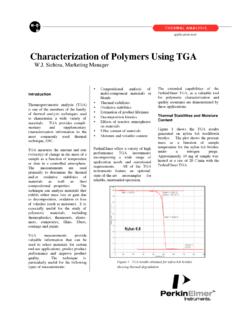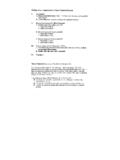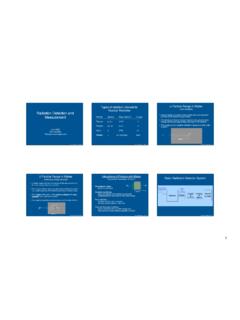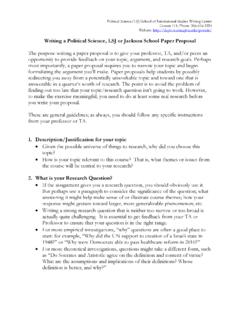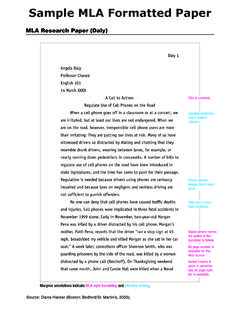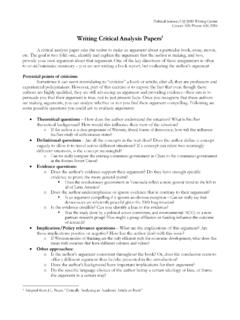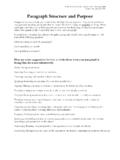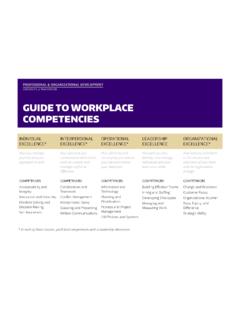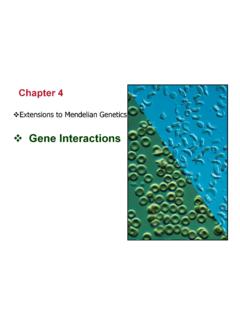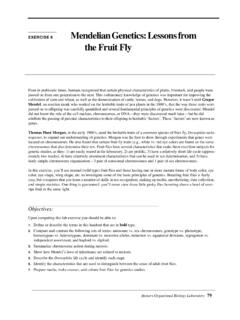Transcription of Introduction – Mendelian inheritance
1 Introduction Mendelian inheritance Genetics 371B Lecture 1 27 Sept. 1999. The mechanism of inheritance . Some early hypotheses: Predetermination , the homunculus theory Blending of traits Introducing a more systematic approach . Gregor Mendel (1822 1884) and his experiments with garden pea But first: Choosing a model organism What is it? Why bother? Features of a good model organism: Some commonly used model organisms: Mendel's organism of choice: garden pea His question: If a pair of plant lines showing a clear character difference are crossed, will the progeny show an intermediate phenotype? He established true-breeding lines . that showed character differences Made crosses (matings) between each pair of lines Example: Character: Phenotypes: x F1 . F1 x F1. F2 . Mendelian Genetics Monohybrid cross Genetics 371B Lecture 2 28 Sept. 1999. Interpreting Mendel's experiment Parents: Gametes: F1 progeny: Gametes: F2 progeny: Conclusions: 1.
2 Determinants are particulate 2. They occur in pairs; one member may be dominant 3. Determinants segregate randomly into gametes Prediction: The F2 Purple class consists of two subclasses: Testing the prediction: What Mendel did: What we would do today (hindsight!): Generality of Mendel's first law: (Not just for pea plants!). Fruit fly (Drosophila melanogaster). Normal (brown) body x black body Mice Agouti x Black Humans Albinism Pedigree analysis What are pedigrees? Why bother with them? Constructing pedigrees The inability to smell methanethiol is a recessive trait in humans. Ashley, Perry, and Gus are three smelling children of Erin (a non-smeller) and Darren (a smeller). Perry's only child is a non-smeller boy. Construct a pedigree for this family, indicating the genotypes where possible.. To be continued . Complications Expressivity Penetrance Do all human traits show simple Mendelian inheritance ?
3 Commonly used pedigree symbols Female Affected individuals Male Heterozgygotes Mating (autosomal recessive). I. 1 2. Parents and Carrier, sex- children (in linked recessive II. order of birth). 1 2. Deceased Dizygotic (nonidentical). twins Stillborn or Monozygotic abortion (identical). twins Proband Sex Consanguineous unspecified marriage Modified monohybrid ratios Genetics 371B Lecture 3 29 Sept. 1999. Snapdragon flower color Red flowers x White flowers Pink flowers Blending of determinants?? How to test? Prediction? .. a case of incomplete dominance Incompletely dominant or recessive? .. in the eye of the beholder? , Tay Sachs disease Symptoms: extreme sensitivity to noise muscle weakness cherry-red spot on retina Affected individuals rarely survive past childhood Defect . Overt phenotype .. At the biochemical level .. Co-dominance , ABO blood group Three possible alleles: A, B, or O. Looking at 3 different crosses : Parental AA x BB AA x OO BB x OO.
4 Genotype AB A B Progeny phenotype Progeny genotype? The curious case of the yellow mice Normal x Yellow mice Interpreting: Which allele is dominant? 1:1 Normal : Yellow Parental genotypes? Yellow x Yellow 2:1 Yellow : Normal What's missing in F2? The physical basis of Mendelian genetics 1902: Boveri and Sutton, Chromosome theory of inheritance . Chromosomes Diploid vs. haploid chromosome number What's in a chromosome? Protein DNA (deoxyribonucleic acid). Subunit: Ribose + Phosphate + base Base: Adenine, Cytosine, Guanine, Thymine DNA as the molecule of inheritance The Hershey-Chase experiment Question: What is passed on from one generation to the next, protein or DNA? Model organism: Bacteriophage T2. The experiment Bacteriophage with Bacteriophage with radioactive DNA radioactive protein Infect bacteria (E. coli). Do progeny virus Do progeny virus have radioactive have radioactive DNA? protein? Conclusion: The cell cycle Genetics 371B Lecture 4 1 Oct.
5 1999. The structure of DNA. Backbone Pairing 5' 3'. phosphate A G T C T ribose sugar T C A G A. 3' 5'. What holds the helices together? Length measure (double-stranded DNA): Human genome: What are alleles? The cell cycle DNA replication G. G. C. A. G. T. A. C. A C C A T C G A. T G G T A G C T. G. T. A. C. T. G. C. C. Cell division: What happens to the chromosomes depends on the goal of the division to make more vegetative cells: to make gametes: Mitosis Partitioning replicated chromosomes Good Bad! or The problem: Partitioning replicated chromosomes so that each daughter cell gets one copy of each chromosome The solution After replication of a chromosome . hold the two sister chromatids together target them to opposite poles then separate the sisters centromere A convenient representation remember that chromosomes don't replication condense and take on this form until Prophase (the start of mitosis).
6 Sister chromatids At Metaphase .. Chromosomes line up at cell's equatorial plate . Mechanism? Spindle fibers exerting tension on kinetochores Once all the chromosomes are lined up . Anaphase Telophase What kinds of defects would make mitosis go haywire? Meiosis and the Chromosome theory Genetics 371B Lecture 5 4 Oct. 1999. Meiosis - making haploid gametes from diploid cells Parent Parent 2N 2N. Gamete Gamete Zygote 2N. The problem: ensuring that homologs are partitioned to separate gametes The solution hold homologous chromosomes together by synapsis and crossing over target homologs to opposite poles then separate the homologs Meiosis proceeds in two steps: Meiosis I reductional division . Meiosis II equational division . Metaphase I Anaphase I. Metaphase II. The chromosome theory of inheritance Based on the congruence of determinant behavior (Mendel) and chromosome behavior (cytology). The essence of the theory: Proof- Based on tests of predictions: transmission of traits should parallel the segregation of specific chromosomes if chromosome segregation is altered the transmission of determinants should be altered also Thomas Hunt Chromosomes of Morgan, 1909: Test Drosophila melanogaster: of the first prediction - in Drosophila Red eyes white eyes white eyes Red x x F1 F1.
7 F2 F2. Morgan's interpretation: w +. + w + w + w + +. w w Conclusion: Calvin Bridges' experiments with exceptional progeny: Test of the 2nd prediction white eyes Red x Expect: Occasionally got: [ primary exceptional progeny ]. Explanation? Rare errors in meiosis mis-segregation of chromosomes Normal MI M II. Abnormal MI M II. X Y sperm XX. eggs O. Conclusions 1. Determinants are on chromosomes 2. In Drosophila, two X = female (one X = male). Sex-linked inheritance Genetics 371B Lecture 6 5 Oct. 1999. Sex determination Female Male Possibilities Fruit fly Y male Humans Birds XX female In humans, the presence of a Y chromosome makes a male: Klinefelter syndrome: XXY. Turner syndrome: XO. How does the Y chromosome cause male-ness? TDF (testis-determining factor) aka SRY gene on the Y chromosome . X Y A. ]. ]. Analyzing pedigrees The process An assumption: The result Examples For each of the following pedigrees, can you decide whether the trait is dominant or recessive?
8 I. 1 2. II. 1 2. III. 1 2 3. IV. 1 2. I. 1 2. II. 1 2 3 4 5. III. 1 2 3 4 5 6 7 8. IV. 1 2 3 4 5. I Is this a recessive trait? 1 2. II. 1 2 3. Sex-linked traits X-linked recessive Consider these pedigrees (to be filled in). X-linked dominant What would you predict for a Y-linked trait? Sex-limited inheritance , hen-feathering in chicken Hen-feathered? Genotype HH. Hh hh Sex-influenced inheritance Mahogany + 4. Red x Red ++ Mahogany 4. For each of the following pedigrees, which modes of inheritance can you eliminate, and why? (Assume complete expressivity and penetrance; also assume that the trait is rare and that unless indicated otherwise, there is no inbreeding.). (A). I. 1 2. II. 1 2 3 4 5 6. III. 1 2 3 4 5 6 7 8. IV. 1 2 3 4 5. (B). I. 1 2. II. 1 2 3 4 5. III. 1 2 3 4 5. IV. 1 2 3. (C). I. 1 2. II. 1 2 3 4 5 6 7 8 9 10. III. 1 2 3 4 5 6 7 8 9 10 11. IV. 1 2 3 4 5 6 7 8 9 10 11. (D). I. 1 2. II.
9 1 2 3 4 5 6 7. III. 1 2 3 4 5 6 7 8. IV. 1 2 3 4 5 6 7. Independent assortment Genetics 371B Lecture 7 6 Oct. 1999. Based on what we know about meiosis expect random segregation of chromosomes Evidence Meiosis in grasshopper testes One heteromorphic chromosome pair; one unpaired chromosome As predicted for random segregation: Therefore expect that segregation of determinants on different chromosomes should be independent of each other Mendel's experiments cont'd . P. Gametes F1. Gametes Segregation of alleles of one gene is independent of segregation at another gene law of independent assortment Branch diagrams consider one phenotype at a time; overall ratio is product of individual ratios RrYy x RrYy AaBbEe x AaBbEe E. Y B. R A e E. y b e E. Y B. e r a E. y b e Predicting the results of crosses . For any multi-factor cross showing independent assortment . How many gamete classes? How many progeny phenotypes?
10 How many progeny genotypes? Need: to be able to predict genotype/ phenotypes ratios large sample sizes systematic way of evaluating whether the observed results are really different from the expected results Probability Genetics 371B Lecture 8 8 Oct. 1999. Predicting outcomes The goal: Estimating the chances of a particular outcome actually occurring Why bother? Consider this pedigree: Aa Aa Is II-1 female or male ? I How probable is each 1 2. outcome? II ? ? 1 2 3 4 Is II-4 A_ or aa ? How probable is each genotype? Probability: of an inevitable event=. of an impossible event=. If x, y, and z are the only possible outcomes of an event, P(x) + P(y) + P(z) =. Imposing multiple conditions Product rule The probability that two or more independent events will occur (event x and event y and ). Examples What is the probability that III-1 will be aa ? I. 1 2. II Aa 1 2 3. III. ? 1. Relaxing the criteria Sum rule The probability of an outcome that can be achieved by more than one way (event x or event y or ).
